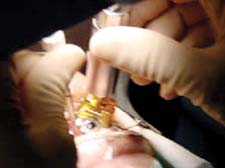Disposable microkeratome can give same results as multi-use
Surgeon cites ease of use, reliability, minimal complications.
Click Here to Manage Email Alerts
SAN FRANCISCO – The Moria CB Single Use disposable microkeratome offers LASIK surgeons the same results as its multi-use counterpart but may be easier to use, according to a surgeon speaking here.
Karl G. Stonecipher, MD, and colleagues measured flap thickness, flap diameter, hinge size and rate of complications in 649 eyes that underwent LASIK with either the Moria CB Single Use 130 or 110. They also compared flap thicknesses on a subset of 88 eyes that were cut with the reusable CB 130.
“I think it’s efficient, accurate and very safe. I think you’re going to like it when you use it. It’s an easy adaptation. There is no real change in the way in which you perform your procedure,” Dr. Stonecipher said at the American Society of Cataract and Refractive Surgery meeting.
Results
|
Dr. Stonecipher used subtractive pachymetry to assess flap thickness. Calipers were used to measure the hinge size and the diameter of the superior-hinged flaps.
The CB Single Use 130 delivered an average flap thickness of 175 mm with a standard deviation of 22.5 mm, he said. With the CB Single Use 110, Dr. Stonecipher recorded a flap thickness of 143 mm with a standard deviation of 23 mm.
Flap thickness ranged from 118 to 285 mm with the CB 130, and from 81 to 197 mm with the CB 110.
“If we eliminate those corneas with extreme pachymetries, we are really running more on the numbers [that are] consistent with what’s on the head,” Dr. Stonecipher said. “So they are about 10 µm off on the 110 and about 20 µm off on the 130.”
The average flap thicknesses would then be 120.6 mm and 152.4 mm respectively for the CB Single Use 130 and 110.
With the reusable CB 130, Dr. Stonecipher and colleagues measured a mean flap thickness of 182.6 mm ± 26 mm; these results are not statistically significantly different from results obtained with the CB Single Use 130, he said.
The average horizontal flap diameter was recorded as 9.4 mm, with a standard deviation of 0.32 mm for both Single Use microkeratomes. The hinge chord length was consistently around 5 mm with a standard deviation of 0.4 mm with both microkeratomes, he said.
Comparing models
Differences in flap thickness between models are generally due to dissimilarities among patients themselves, Dr. Stonecipher said in an interview. For example, the level of corneal hydration may affect measurements and results from eye to eye.
Variations in the microkeratome’s speed of pass may also account for differences in flap thickness, he said. Faster forward speed produces thinner flaps.
However, surgeons can still use the same nomogram for choosing a ring size as they did with the conventional Moria microkeratome, he added. Moreover, the similarities between the models will make it easier for surgeons who choose to switch to the Single Use, he said.
Minimal complications
Dr. Stonecipher and colleagues observed no incidence of buttonholes, free caps, incomplete or irregular flaps or anterior chamber perforations with either model of the CB Single Use microkeratome. Epithelial trauma occurred in 3% of patients who underwent LASIK with the disposable CB Single Use 130 and in a comparable 2.2% of CB Single Use 110 patients.
He noted that with the single-use CB 130, “we did see some loose epithelium, and it was consistent with what we’ve seen before with the CB metal.”
Diffuse lamellar keratitis was seen in 0.55% of patients, which “was nothing outside of normal,” Dr. Stonecipher said. He reported no incidence of DLK with the CB 110.
Moria has also introduced a CB 90, which is currently being evaluated by Roger Steinert, MD, and Stephen Dudley, MD, Dr. Stonecipher said. Preliminary results with the CB 90 yielded an average flap thickness of 108 mm (standard deviation 16 mm, range 80 to 146 mm). Fifty eyes had undergone LASIK with the CB 90 at the time the study was released. Results on horizontal diameter and hinge chord length were not yet available.
Advantages
One of the greatest advantages of using a disposable microkeratome is the ability to use a new, presterilized head for each patient, according to Dr. Stonecipher.
“We’re trying to eliminate the cleaning component as well. It’s a more efficient way in which to provide a keratome blade. It’s easy to convert to. It doesn’t change anything you really do other than just screw it on and go,” he said.
Within 1 day postop, 61% of patients who underwent LASIK with the CB Single Use 130 achieved uncorrected visual acuity of 20/20. Of the CB Single Use 110 patients, 58% achieved this result.
Whatever the quantity ordered, the price of a CB Single Use head with its preassembled blade is $56, which is identical to the price of the CB blade, Dr. Stonecipher said.
“I didn’t notice any difference, period, other than that all my technician had to do was screw it on the motor. It was much easier to use,” he said.
For Your Information:
- Karl G. Stonecipher, MD, can be reached at Southeastern Laser and Refractive Center, 3312 Battleground Ave., Greensboro, NC 27410; (336) 282-5000; fax: (336) 282-5022; e-mail: stonenc@aol.com. Dr. Stonecipher has no direct financial interest in the products mentioned in this article, nor is he a paid consultant for any companies mentioned.
- Moria Inc., makers of the CB Single Use disposable microkeratome, can be reached at 1050 Cross Keys Drive, Doylestown, PA 18901; (215) 230-7662; fax: (215) 230-7670; e-mail: moriausa@moriausa.com; Web site: www.moria-surgical.com.

